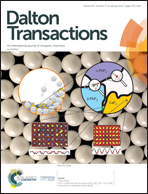A novel type of organometallic 2-R-2,4-dihydro-1H-3,1-benzoxazine with R = [M(η5-C5H4)(CO)3] (M = Re or Mn) units. Experimental and computational studies of the effect of substituent R on ring-chain tautomerism†
Abstract
The syntheses, characterization, X-ray crystal structures, electrochemical properties and anticancer and antichagasic activities of the first examples of 2-substituted 2,4-dihydro-1H-3,1-benzoxazines with half-sandwich organometallic arrays, [M(η5-C5H4)(CO)3] (M = Re or Mn), at position-2 are described. Experimental and computational studies based on DFT calculations on the open forms [Schiff bases of general formulae R-CH![[double bond, length as m-dash]](https://www.rsc.org/images/entities/char_e001.gif) N-C6H4-2-CH2OH] (5), with R = ferrocenyl (a), phenyl (b), cyrhetrenyl (c) or cymantrenyl (d), and their tautomeric forms (2-substituted 2,4-dihydro-1H-3,1 benzoxazines) have allowed us to establish the influence of substituents a–d and solvents on: (a) the extent of tautomeric equilibria (5a–5d) ↔ (6a–6d) and (b) their electrochemical properties and the electronic distribution on the open and closed forms. Despite the formal similarity between 6c and 6d, their anticancer and antiparasitic activities are markedly different. Compound 6d is inactive in the HCT116, MDA-MB231 and MCF7 cancer cell lines, but 6c shows moderate activity in the latter cell line, while the Mn(I) complex (6d) is a more potent anti-Trypanosoma cruzi agent than its Re(I) analogue (6c).
N-C6H4-2-CH2OH] (5), with R = ferrocenyl (a), phenyl (b), cyrhetrenyl (c) or cymantrenyl (d), and their tautomeric forms (2-substituted 2,4-dihydro-1H-3,1 benzoxazines) have allowed us to establish the influence of substituents a–d and solvents on: (a) the extent of tautomeric equilibria (5a–5d) ↔ (6a–6d) and (b) their electrochemical properties and the electronic distribution on the open and closed forms. Despite the formal similarity between 6c and 6d, their anticancer and antiparasitic activities are markedly different. Compound 6d is inactive in the HCT116, MDA-MB231 and MCF7 cancer cell lines, but 6c shows moderate activity in the latter cell line, while the Mn(I) complex (6d) is a more potent anti-Trypanosoma cruzi agent than its Re(I) analogue (6c).
![Graphical abstract: A novel type of organometallic 2-R-2,4-dihydro-1H-3,1-benzoxazine with R = [M(η5-C5H4)(CO)3] (M = Re or Mn) units. Experimental and computational studies of the effect of substituent R on ring-chain tautomerism](/en/Image/Get?imageInfo.ImageType=GA&imageInfo.ImageIdentifier.ManuscriptID=C8DT03265C&imageInfo.ImageIdentifier.Year=2019)


 Please wait while we load your content...
Please wait while we load your content...